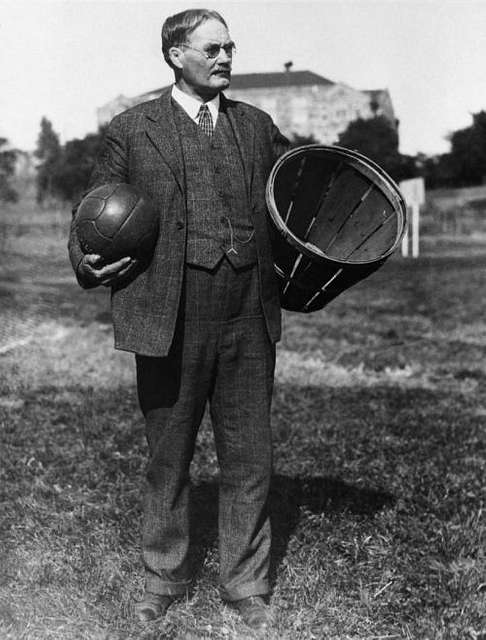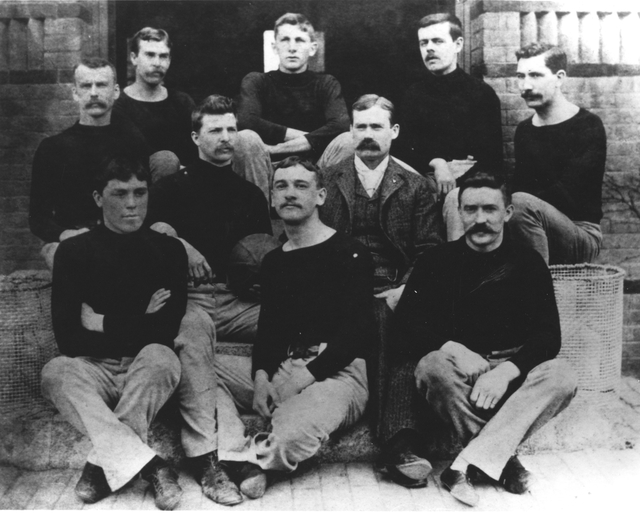On this day in 1892, Dr. James Naismith published the rules for a game he invented to keep his rowdy class occupied, later known as basketball.
Dr. James Naismith was a lifetime sports-lover, which is why he pursued a degree in Physical Education and played several of McGill University’s offered sports, like Canadian football, lacrosse, rugby, soccer, and gymnastics.
In 1891, Naismith left his position as Director of Athletics at his alma mater and worked as a PE teacher at the YMCA International Training School in Springfield, Massachusetts. His class was full of energy and often distracted, so Dr. Naismith started brainstorming a game they could play indoors during the cold New England winter month. He wanted to invent a game that didn’t require too much space, kept athletes in shape, and be as fair as possible.

To keep the game safe, Naismith decided that players could only pass the ball to each other in order to avoid dribbling and, therefore, avoid the majority of the physical contact that might lead to injury. Another idea Naismith had to keep the game safe was to make the goal taller than all of his players, so nobody could perfectly guard it with their body.
For the basket, he used old peach baskets from the school cafeteria and cut the bottoms of each of them so that the ball could gently fall through needing to be retrieved from the top.
Despite his many precautions, Naismith quickly realized his game was not entirely safe. Several of his students “ended up in a free-for-all in the middle of the gym floor,” resulting in some black eyes, one separated shoulder, and one student who was knocked unconscious, according to Mystic Stamp.
Despite the small injuries, the students loved the game and eventually got the hang of playing without winding up injured, so Dr. Naismith decided to publish his 13 rules of basketball in The Triangle, a local journal.
The Dr.’s original rules for basketball went as follows:
1. The ball may be thrown in any direction with one or both hands.
2. The ball may be batted in any direction with one or both hands (never with the fist).
3. A player cannot run with the ball. The player must throw it from the spot on which he catches it, allowance to be made for a man who catches the ball when running at a good speed if he tries to stop.
4. The ball must be held in or between the hands, the arms or body must not be used for holding it.
5. No shouldering, holding, pushing, tripping, or striking in any way the person of an opponent shall be allowed; the first infringement of this rule by any player shall count as a foul, the second shall disqualify him until the next goal is made, or, if there was evident intent to injure the person, for the whole of the game, no substitute allowed.
6. A foul is striking at the ball with the fist, violation of rules 3, 4, and such as described in rule 5.
7. If either side makes three consecutive fouls, it shall count a goal for the opponents (consecutive means without the opponents in the meantime making a foul).
8. A goal shall be made when the ball is thrown or batted from the grounds into the basket and stays there, providing those defending the goal do not touch or disturb the goal. If the ball rests on the edges, and the opponent moves the basket, it shall count as a goal.
9. When the ball goes out of bounds, it shall be thrown into the field of play by the person first touching it. In case of a dispute, the umpire shall throw it straight into the field. The thrower is allowed five seconds, if he holds it longer, it shall go to the opponent. If any side persists in delaying the game, the umpire shall call a foul on that side
10. The umpire shall be judge of the men and shall note the fouls and notify the referee when three consecutive fouls have been made. He shall have power to disqualify men according to Rule 5.
11. The referee shall be judge of the ball and shall decide when the ball is in play, in bounds, to which side it belongs, and shall keep the time. He shall decide when a goal has been made, and keep account of the goals with any other duties that are usually performed by a referee.
12. The time shall be two fifteen minutes, halves, with five minutes’ rest between.
13. The side making the most goals in that time shall be declared the winner. In case of a draw, the game may, by agreement of the captains, be continued until another goal is made.
Little did Naismith know, he’d created an international sensation which would become an official Olympic sport in 1936 and eventually explode into a multi-million dollar industry.



